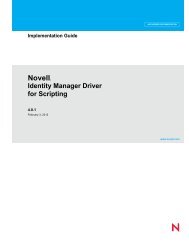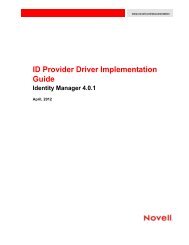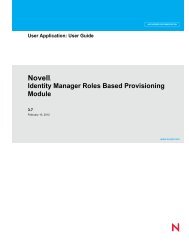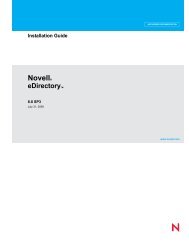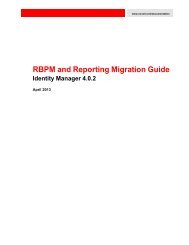Novell LDAP Proxy 1.0 Administration Guide - NetIQ
Novell LDAP Proxy 1.0 Administration Guide - NetIQ
Novell LDAP Proxy 1.0 Administration Guide - NetIQ
Create successful ePaper yourself
Turn your PDF publications into a flip-book with our unique Google optimized e-Paper software.
• Section 3.7.4, “Search Request Policy,” on page 41<br />
• Section 3.7.5, “Connection Route Policy,” on page 45<br />
• Section 3.7.6, “Replace String Policy,” on page 48<br />
3.7.1 Client Network Policy<br />
The Client Network policy must be defined in the node of the XML configuration<br />
file.<br />
For instance, assume that you want to define a simple Client Network policy that has one condition<br />
and its relevant action and default action. Any incoming client requests from a network with an IP<br />
address equal to 192.168.<strong>1.0</strong> and with subnet bits equal to 24 must be allowed to establish a<br />
connection. You can define the configuration as follows:<br />
To add a Client Network policy:<br />
1 Open the nlpconf.xml file from the /etc/opt/novell/ldapproxy/conf directory in any<br />
XML editor.<br />
2 To add a Client Network policy, create an instance within the node. Use the<br />
sample configuration as a pattern. You must define the policy as the first policy in the node.<br />
3 Define a name to identify the policy, a set of conditions, an action, and a default action for the<br />
policy.<br />
For more information on the elements and attributes that are used to define a Client Network<br />
policy, refer to “Configuring a Client Network Policy” on page 35.<br />
4 To add more Client Network policies, repeat Step 2 to Step 3.<br />
5 Save the nlpconf.xml file.<br />
Configuring a Client Network Policy<br />
The following elements and parameters are used to configure Client Network policies:<br />
Manually Configuring <strong>Novell</strong> <strong>LDAP</strong> <strong>Proxy</strong> 35




